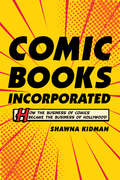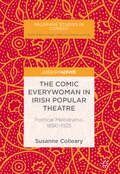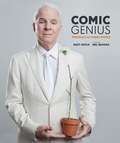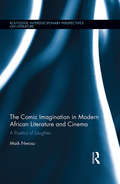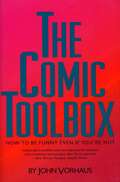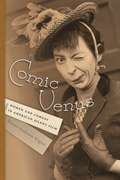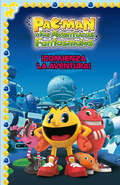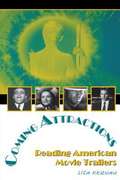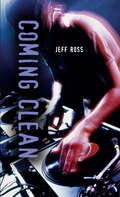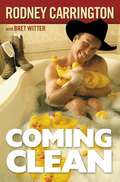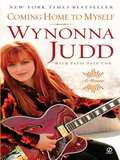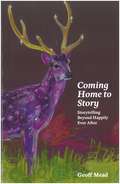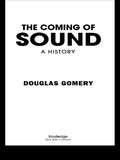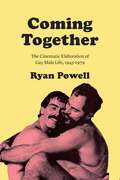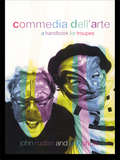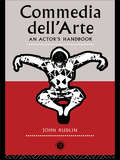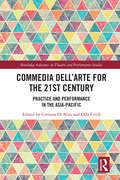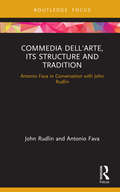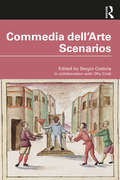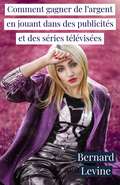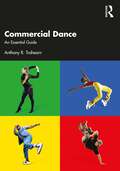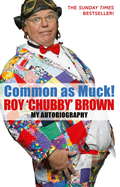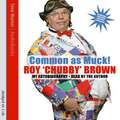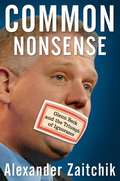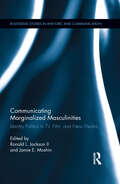- Table View
- List View
Comic Books Incorporated: How the Business of Comics Became the Business of Hollywood
by Shawna KidmanComic Books Incorporated tells the story of the US comic book business, reframing the history of the medium through an industrial and transmedial lens. Comic books wielded their influence from the margins and in-between spaces of the entertainment business for half a century before moving to the center of mainstream film and television production. This extraordinary history begins at the medium’s origin in the 1930s, when comics were a reviled, disorganized, and lowbrow mass medium, and surveys critical moments along the way—market crashes, corporate takeovers, upheavals in distribution, and financial transformations. Shawna Kidman concludes this revisionist history in the early 2000s, when Hollywood had fully incorporated comic book properties and strategies into its business models and transformed the medium into the heavily exploited, exceedingly corporate, and yet highly esteemed niche art form we know so well today.
The Comic Everywoman in Irish Popular Theatre: Political Melodrama, 1890-1925 (Palgrave Studies in Comedy)
by Susanne CollearyThis book is a comprehensive study of comic women in performance as Irish Political Melodrama from 1890 to 1925. It maps out the performance contexts of the period, such as Irish “poor” theatre both reflecting and complicating narratives of Irish Identity under British Rule. The study investigates the melodramatic aesthetic within these contexts and goes on to analyse a selection of the melodramas by the playwrights J.W. Whitbread and P.J. Bourke. In doing so, the analyses makes plain the comic structures and intent that work across both character and action, foregrounding comic women at the centre of the discussion. Finally, the book applies a “practice as research” dimension to the study. Working through a series of workshops, rehearsals and a final performance, Colleary investigates comic identity and female performance through a feminist revisionist lens. She ultimately argues that the formulation of the Comic Everywoman as staged “Comic” identity can connect beyond the theatre to her “Everyday” self. This book is intended for those interested in theatre histories, comic women and in popular performance.
Comic Genius
by Matt Hoyle Mel BrooksThis star-studded tribute to the kings and queens of comedy draws together such legendary names as Steve Martin, Tina Fey, Steve Carell, Eddie Murphy, Robin Williams, Ricky Gervais, and many more. Granted extraordinary access, photographer Matt Hoyle has captured his subjects in portraits that are works of art in themselves--by turns zany and deadpan, laugh-out-loud and contemplative. Accompanying them are first-person reflections from each of the comedians on life and laughter that always cut straight to the heart of comedy: it's funny because it's true. Page after sidesplitting page in Comic Genius offers prose as engaging as each portrait is memorable. Here, in one handsome package, is the gift of laughter itself. Comic Genius is proud to support Save The Children.
The Comic Imagination in Modern African Literature and Cinema: A Poetics of Laughter (Routledge Interdisciplinary Perspectives on Literature)
by Maik NwosuThis book is a seminal study that significantly expands the interdisciplinary discourse on African literature and cinema by exploring Africa’s under-visited carnivalesque poetics of laughter. Focusing on modern African literature as well as contemporary African cinema, particularly the direct-to-video Nigerian film industry known as Nollywood, the book examines the often-neglected aesthetics of the African comic imagination. In modern African literature, which sometimes creatively traces a path back to African folklore, and in Nollywood — with its aesthetic relationship to Onitsha Market Literature — the pertinent styles range from comic simplicitas to comic magnitude with the facilitation of language, characterization, and plot by a poetics of laughter or lightness as an important aspect of style. The poetics at work is substantially carnivalesque, a comic preference or tendency that is attributable, in different contexts, to a purposeful comic sensibility or an unstructured but ingrained or virtual comic mode. In the best instances of this comic vision, the characteristic laughter or lightness can facilitate a revaluation or reappreciation of the world, either because of the aesthetic structure of signification or the consequent chain of signification. This referentiality or progressive signification is an important aspect of the poetics of laughter as the African comic imagination variously reflects, across genres, both the festival character of comedy and its pedagogical value. This book marks an important contribution to African literature, postcolonial literature, world literature, comic imagination, poetics, critical theory, and African cinema.
The Comic Toolbox: How To Be Funny Even If You're Not
by John VorhausA workbook approach to comedy writing as creative problem-solving. It offers tools of the trade such as Clash of Context, Tension and Release, The Law of Comic Opposites, The Wildly Inappropriate Response, and The Myth of the Last Great Idea to writers, comics, and anyone else who wants to be funny.
Comic Venus: Women And Comedy In American Silent Film (Contemporary Approaches To Film And Media Ser.)
by Kristen Anderson WagnerFor many people the term “silent comedy” conjures up images of Charlie Chaplin’s Little Tramp, Buster Keaton’s Stoneface, or Harold Lloyd hanging precariously from the side of a skyscraper. Even people who have never seen a silent film can recognize these comedians at a glance. But what about the female comedians? Gale Henry, Louise Fazenda, Colleen Moore, Constance Talmadge—these and numerous others were wildly popular during the silent film era, appearing in countless motion pictures and earning top salaries, and yet, their names have been almost entirely forgotten. As a consequence, recovering their history is all the more compelling given that they laid the foundation for generations of funny women, from Lucille Ball to Carol Burnett to Tina Fey. These women constitute an essential and neglected sector of film history, reflecting a turning point in women’s social and political history. Their talent and brave spirit continues to be felt today, and Comic Venus: Women and Comedy in American Silent Film seeks to provide a better understanding of women’s experiences in the early twentieth century, and to better understand and appreciate the unruly and boundary-breaking women who have followed. The diversity and breadth of archival materials explored in Comic Venus illuminate the social and historical period of comediennes and silent film. In four sections, Kristen Anderson Wagner enumerates the relationship between women and comedy, beginning with the question of why historically women weren’t seen as funny or couldn’t possibly be funny in the public and male eye, a question that persists even today. Wagner delves into the idea of women’s “delicate sensibilities,” which presumably prevented them from being funny, and in chapter two traces ideas about feminine beauty and what a woman should express versus what these comedic women did express, as Wagner notes, “comediennes challenged the assumption that beauty was a fundamental component of ideal femininity.” In chapter three, Wagner discusses how comediennes such as Clara Bow, Marie Dressler, and Colleen Moore used humor to gain recognition and power through performances of sexuality and desire. Women comedians presented “sexuality as fun and playful, suggesting that personal relationships could be fluid rather than stable.” Chapter four examines silent comediennes’ relationships to the modern world and argues that these women exemplified modernity and new womanhood. The final chapter of Comic Venus brings readers to understand comediennes and their impact on silent-era cinema, as well as their lasting influence on later generations of funny women. Comic Venus is the first book to explore the overlooked contributions made by comediennes in American silent film. Those with a taste for film and representations of femininity in comedy will be fascinated by the analytical connections and thoroughly researched histories of these women and their groundbreaking movements in comedy and stage.
¡Comienza la aventura! (Pac-Man. Primeras lecturas #Volumen)
by Varios Autores¡Alucina con esta aventura de Pac-Mac! Pac es el típico adolescente del Pac mundo excepto por tres pequeños detalles: es amarillo, redondo y, para su sorpresa, es el enemigo número 1 del malvado Lord Betrayus, el líder del Mundo de las Tinieblas. Pac y su pandilla emprenden una batalla contra los fantasmas para salvar su mundo y, sobre todo, para divertirse haciéndolo.
Coming Attractions: Reading American Movie Trailers
by Lisa KernanStarting from the premise that movie trailers can be considered a film genre, this pioneering book explores the genre's conventions and offers a primer for reading the rhetoric of movie trailers. Lisa Kernan identifies three principal rhetorical strategies that structure trailers: appeals to audience interest in film genres, stories, and/or stars. She also analyzes the trailers for twenty-seven popular Hollywood films from the classical, transitional, and contemporary eras, exploring what the rhetorical appeals within these trailers reveal about Hollywood's changing conceptions of the moviegoing audience. Kernan argues that movie trailers constitute a long-standing hybrid of advertising and cinema and, as such, are precursors to today's heavily commercialized cultural forms in which art and marketing become increasingly indistinguishable.
Coming Clean (Orca Soundings)
by Ross JeffRob wants to be a DJ - more than anything. And when his older brother Adam lands him a gig at a local all-ages club filling in for DJ Sly, Rob is ecstatic. This could be his big break, and when he finds out that the girl of his dreams will be there that first night, it seems like it is all coming together. But things fall apart - Mary Jane overdoses on Ecstasy provided by Adam, and DJ Sly turns Adam in and implicates Rob. The brothers end up on the run, evading the police while trying to force DJ Sly to tell the truth about the brothers' part in the death and Sly's own role in supplying drugs at the club.
Coming Clean
by Bret Witter Rodney CarringtonChart-topping comedian Rodney Carrington offers up his first book helping of the Texas-sized, down-home humor that has sold out his comedy tour across the nation.
Coming Home to Myself
by Wynonna JuddThe no-holds-barred memoir from the beloved music superstar. From the heart of one of the most beloved performers in music comes a candid memoir of professional triumph, private heartbreak, and personal victory-a coming-of-age account of a very private search for harmony and a very public rise to fame. Coming Home to Myselfis the result of that emotional journey-a song of personal discovery that taught Wynonna Judd to love not just what she does, but who she is. From a truly exceptional woman comes an unexpected memoir of survival, strength, hope, and forgiveness, filled with an exultant and empowering message certain to resonate with those who have dreamed of finding themselves, and who only needed the courage and inspiration to begin their own journey.
Coming Home to Story: Storytelling Beyond Happily Ever After
by Geoff MeadStories take us into other worlds so that we may experience our own more deeply. Master storyteller Geoff Mead brings the reader inside the experience of telling and listening to a story. He shows how stories and storytelling engage our imaginations, strengthen communities and bring adventure and joy into our lives. The narrative is interspersed with consummate retellings of traditional tales from all over the world.
The Coming of Sound
by Douglas GomeryThe coming of sound to film was an event whose importance can hardly be overestimated; sound transformed not only the Hollywood film industry but all of world cinema as well. As economic and film historian Douglas Gomery explains, the business of film became not only bigger but much more complex. As sound spread its power, the talkies became an agent of economic and social change through the globe, extending America's reach in ways that had never before been imaginable.This is an essential work for anyone interested in early film, film history and economics, and the history of the American media.
Coming Together: The Cinematic Elaboration of Gay Male Life, 1945-1979
by Ryan PowellIn Coming Together, Ryan Powell captures the social and political vitality of the first wave of movies made by, for, and about male-desiring men in the United States between World War II and the 1980s. From the underground films of Kenneth Anger and the Gay Girls Riding Club to the gay liberation-era hardcore films and domestic dramas of Joe Gage and James Bidgood, Powell illuminates how central filmmaking and exhibition were to gay socializing and worldmaking. Unearthing scores of films and a trove of film-related ephemera, Coming Together persuasively unsettles popular histories that center Stonewall as a ground zero for gay liberation and visibility. Powell asks how this generation of movie-making—which defiantly challenged legal and cultural norms around sexuality and gender—provided, and may still provide, meaningful models for living.
Commedia Dell'Arte: A Handbook for Troupes
by Oliver Crick John RudlinA companion to John Rudlin's best-selling Commedia dell'Arte: A Handbook for Actors, this book covers both the history and professional practice of commedia dell'arte companies from 1568 to the present day. Indispensable for both the beginner and the professional, it contains historical and contemporary company case histories, details on company organisation, and tips on practical stagecraft. Essential for students and practitioners, this book enables the reader to understand how successful commedia dell'arte companies function, and how we can learn from past and current practice to create a lively and dynamic form of theatre. Includes tips on: * writing a scenario * mask-making * building a stage * designing a backdrop * costume * music. _
Commedia Dell'arte An Actor's Handbook: An Actor's Handbook
by John RudlinThere has been an enormous revival of interest in Commedia dell'arte. And it remians a central part of many drama school courses. In Commedia dell'arte in the Twentieth Century John Rublin first examines the orgins of this vital theatrical form and charts its recent revival through the work of companies like Tag, Theatre de Complicite and the influential methods of Jacques Lecoq. The second part of the book provides a unique practical guide for would-be practitioners: demonstrating how to approach the roles of Zanni, Arlecchion, Brighella, Pantalone, Dottore, and the Lovers in terms of movement, mask-work and voice. As well as offering a range of lazzi or comic business, improvisation exercises, sample monologues, and dialogues. No other book so clearly outlines the specific culture of Commedia or provides such a practical guide to its techniques. This immensely timely and useful handbook will be an essential purchase for all actors, students, and teachers.
Commedia dell’Arte for the 21st Century: Practice and Performance in the Asia-Pacific (Routledge Advances in Theatre & Performance Studies)
by Corinna Di Niro Olly CrickThis book discusses the evolution of Commedia dell’Arte in the Asia-Pacific where through the process of reinvention and recreation it has emerged as a variety of hybrids and praxes, all in some ways faithful to the recreated European genre. The contributors in this collection chart their own training in the field and document their strategies for engaging with this form of theatre. In doing so, this book examines the current thoughts, ideas, and perceptions of Commedia – a long-standing theatre genre, originating in a European-based collision between neo-classical drama and oral tradition. The contributing artists, directors, teachers, scholars and theatre-makers give insight into working styles, performance ideas, craft techniques and ways to engage an audience for whom Commedia is not part of their day-to-day culture. The volume presents case studies by current practitioners, some who have trained under known Commedia ‘masters’ (e.g. Lecoq, Boso, Mazzone-Clementi and Fava) and have returned to their country of origin where they have developed their performance and teaching praxis, and others (e.g. travelling from Europe to Japan, Thailand, Singapore and China) who have discovered access points to share or teach Commedia in places where it was previously not known. This book will be of great interest to students and scholars in Performing arts, Italian studies, and History as well as practitioners in Commedia dell’Arte.
Commedia dell'Arte, its Structure and Tradition: Antonio Fava in Conversation with John Rudlin
by John Rudlin Antonio FavaCommedia dell'Arte, its Structure and Tradition chronicles a series of discussions between two renowned experts in commedia dell'arte – master practitioners Antonio Fava and John Rudlin. These discussions were recorded during three recent visits by Fava to Rudlin’s rural retreat in south west France. They take in all of commedia dell'arte's most striking and enduring elements – its masks, its scripts and scenarios, and most outstandingly, its cast of characters. Fava explores the role of each stock Commedia character and their subsequent incarnations in popular culture, as well as their roots in prominent figures of their time. The lively and wide-ranging conversations also take in methods of staging commedia dell'arte for contemporary audiences, the evolution of its gestures, and the collective nature of its theatre-making. This is an essential book for any student or practitioner of commedia dell'arte – provocative, expansive wisdom from the modern world's foremost exponent of the craft.
Commedia dell'Arte Scenarios
by Sergio Costola Olly CrickCommedia dell'Arte Scenarios gathers together a collection of scenarios from some of the most important Commedia dell'Arte manuscripts, many of which have never been published in English before. Each script is accompanied by an editorial commentary that sets out its historical context and the backstory of its composition and dramaturgical strategies, as well as scene summaries, and character and properties lists. These supplementary materials not only create a comprehensive picture of each script’s performance methods but also offer a blueprint for readers looking to perform the scenarios as part of their own study or professional practice. This collection offers scholars, performers and students a wealth of original performance texts that brig to life one of the most foundational performance genres in world theatre.
Comment gagner de l’argent en jouant dans des publicités et des séries télévisées
by Bernard LevineAvez-vous déjà souhaité obtenir un emploi en apparaissant dans des publicités télévisées? ....comme les publicités des téléphones portables Samsung ou Nokia, les publicités de McDonald's ou Coca Cola. Aimeriez-vous jouer un rôle dans une série télévisée ou un feuilleton? Aucune expérience n'est nécessaire. Pour vous, voici venue l'occasion de réaliser vos rêves. C'est tellement amusant et l'argent que vous y gagnerez le vaudra bien!
Commercial Dance: An Essential Guide
by Anthony R. TrahearnThis is an exploration of the vital and rapidly evolving world of Commercial Dance, tracing the evolution and merging of Hip-Hop, Club and Jazz dance styles from the music videos of the early 1980s, to today's huge influence on pop music and dance in a multi-media culture. Chapters including ‘Iconic Moments’ and ‘Main Movers’ contextualise and analyse culturally significant works and choreographers. With direct contributions from an international array of industry leading dancers, choreographers and creatives - including JaQuel Knight (Beyonce’s choreographer), Rich + Tone Talauega (Madonna & Michael Jackson collaborators), Rebbi Rosie (Rihanna’s dancer), Dean Lee (Janet Jackson’s choreographer) and Kiel Tutin (BLACKPINK’s choreographer) - this book shines a light on the creatives in the Commercial Dance industry who have made significant impacts, not just on the world of dance but on popular culture itself. Chapters discussing dance history, copyright law, inclusivity and dance class culture as well as additional contributions from dance scholars enable this book to give credence to Commercial Dance as a legitimate academic area of study. This is a complete and comprehensive textbook for all dance students at any level of study on college, university or conservatory courses.
Common As Muck!: The Autobiography of Roy 'Chubby' Brown
by Roy Chubby BrownBy the time he was nineteen, Royston Vasey had married, divorced, fathered two children, spent two years in Britain's toughest Borstal, served three prison stretches and been stabbed while in the Merchant Navy. He thought his only career choice would be a life of crime. Fifteen years later, he was one of Britain's most successful comics, playing live to half a million fans a year as Roy 'Chubby' Brown. COMMON AS MUCK! tells an incredible story of hardships, heartbreak and, ultimately, success. From an impoverished childhood with his abusive father, to his brand of comedy too rude for television and his determined fight against throat cancer, COMMON AS MUCK! is a frank telling of a remarkable life, laced with Roy's irrepressible humour.
Common As Muck!: The Autobiography of Roy 'Chubby' Brown
by Roy Chubby BrownAbandoned by his mother when he was just nine years old, by the time Royston Vasey was nineteen he had been married, divorced, had two children, spent two years in Borstal and several months in prison, and had been shot at in the Merchant Navy. By the time he was thirty-five, he was one of Britain's most successful comics, playing live to half a million fans a year as Roy 'Chubby' Brown. In Common as Muck he tells his incredible story. Frank, funny and - perhaps unexpectedly - often moving, it is a tale of a man battling to escape his background and become a star. From his impossibly deprived childhood to his controversial comic persona to his more recent battle against throat cancer, Roy 'Chubby' Brown's life is as remarkable and fascinating as the man himself.
Common Nonsense: Glenn Beck and the Triumph of Ignorance
by Alexander ZaitchikWho is this guy and why are people listening? Forget Rush Limbaugh, Bill O'Reilly, and Sean Hannity--Glenn Beck is the right's new media darling and the unofficial leader of the conservative grassroots. Lampooned by the left and lionized by the far right, his bluster-and-tears brand of political commentary has commandeered attention on both sides of the aisle. Glenn Beck has emerged over the last decade as a unique and bizarre conservative icon for the new century. He fantasizes aloud about killing his political opponents and encourages his listeners to embrace a cynical paranoia that slides easily into a fantasyland filled with enemies that do not exist, and solutions that are incoherent, at best. Since the election of Barack Obama, Beck's bombastic, conspiratorial, and often viciously personal approach to political combat has made him one of the most controversial figures in the history of American broadcasting. In Common Nonsense, investigative reporter Alexander Zaitchik explores Beck's strange brew of ratings lust, boundless ego, conspiratorial hard-right politics, and gimmicky morning-radio entertainment chops. Separates the facts from the fiction, following Beck from his troubled childhood to his recent rise to the top of the conservative media heap. Zaitchik's recent three-part series in Salon caused so much buzz, Beck felt the need to attack it on his show. Based on Zaitchik's interviews with former Beck coworkers and review of countless Beck writings and television and radio shows. Examines Beck's high-profile obsessions (Acorn and Van Jones) as well as his lesser-known influences (obscure Mormon radicals like Cleon Skousen.) Zaitchik's writing has appeared in the New Republic, the Nation, Salon, Wired, the New York Times, and AlternetBeck, a perverse and high-impact media spectacle, has emerged as a leader in a conservative protest movement that raises troubling questions about the health of American democracy.
Communicating Marginalized Masculinities: Identity Politics in TV, Film, and New Media (Routledge Studies in Rhetoric and Communication #11)
by Ronald L. Jackson II Jamie E. MoshinFor years, research concerning masculinities has explored the way that men have dominated, exploited, and dismantled societies, asking how we might make sense of marginalized masculinities in the context of male privilege. This volume asks not only how terms such as men and masculinity are socially defined and culturally instantiated, but also how the media has constructed notions of masculinity that have kept minority masculinities on the margins. Essays explore marginalized masculinities as communicated through film, television, and new media, visiting representations and marginalized identity politics while also discussing the dangers and pitfalls of a media pedagogy that has taught audiences to ignore, sidestep, and stereotype marginalized group realities. While dominant portrayals of masculine versus feminine characters pervade numerous television and film examples, this collection examines heterosexual and queer, military and civilian, as well as Black, Japanese, Indian, White, and Latino masculinities, offering a variance in masculinities and confronting male privilege as represented on screen, appealing to a range of disciplines and a wide scope of readers.
